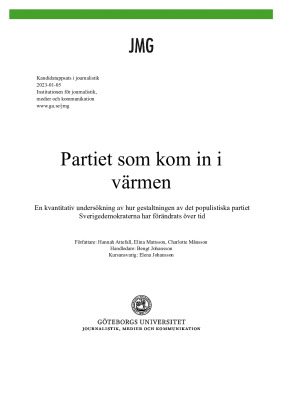Partiet som kom in i värmen
En kvantitativ undersökning av hur gestaltningen av det populistiska partiet
Sverigedemokraterna har förändrats över tid
Abstract
Title: The party which entered the warmth
Authors: Hannah Attefall, Elina Mattsson and Charlotte Månsson
Level: Bachelor thesis in Journalism
Term: HT 2022
Supervisor: Bengt Johansson
Aim of thesis: The purpose of this study is to explore how the Swedish populist party, the Swedish Democrats, have been framed in the morning newspapers and in the evening newspapers one week before the Swedish election 2010 and 2022. By doing this we want to see if and how newspapers have changed the way they frame a populistic party as the Swedish Democrats has achieved major parliamentary success.
Theoretical framework: The theoretical framework used in this study is the framing theory. To better understand how the populist party, the Swedish Democrats, have been framed in the Swedish newspapers we have mainly focused on the already existing framing theory based on the meanings given to populism in the Nordic press (Herkman, 2016a).
Methods(s): The study uses a quantitative content analysis of 409 articles about the Swedish Democrats published in the morning newspapers Dagens Nyheter and Svenska Dagbladet, and the evening newspapers Aftonbladet and Expressen. We used the search words SD and Sverigedemokrat* to collect the relevant articles. The articles extend from one week before the Swedish election 2010 and 2022 until one day before the election day. The theoretical framework has been operationalized to create a codebook for analyzing the articles.
Results: The results of the study show that the most common way to frame the populist party, the Swedish Democrats, in newspapers was to frame them like any other normal parliamentary party. This shows that the populistic party has become more normalized since the election 2010, which was the first time they won seats in the Swedish parliament. The results also show that there have been changes in the way newspapers frame the party between the years 2010 and 2022. For example, it was more common to frame the Swedish Democrats xenophobic in 2010, compared to 2022. However it has become more common to frame them xenophobic in editorial pages, which does not go hand in hand with the overall result. The result also shows that it is more common for evening newspapers to frame the Swedish Democrats as a party which is irresponsible and uses ugly tricks to get ahead, whereas in the morning newspapers it is more usual to describe the party as nationalistic.
Key words: Populism, the Swedish Democrats, framing theory, morning newspaper, evening newspaper, journalism, radical right
Nyckelord: Populism, Sverigedemokraterna, gestaltningsteorin, morgontidning, kvällstidning, journalistik, radikal höger

